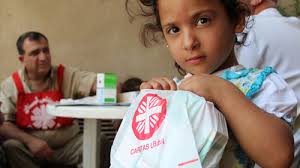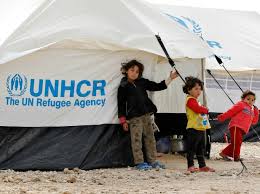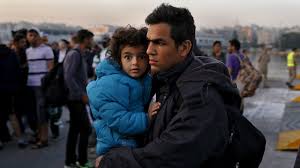Is technology driving change for a sustainable tomorrow or driving mankind closer to the edge…
That poor Syrian boy who
drowned escaping the conflict and was washed ashore for the world to see on social
media is a perfect example of the savage conflicts that we were blissfully
unware of just a few short years ago. We all ask, why? How could they? Who is
to blame?
I have thought somewhat
about that poor boy and the countless numbers of poor unfortunates of all ages
whose only crime is being born in a country ruined by heartless state thugs and
barbarous religious fanatics whom cannot seem to agree on anything in practice
other than the majority of people are not innocents, but pawns in
their sick game that shows no sign of abating to reason, compassion and what
ever humanity maybe left in their hearts!
So focusing on nations
who still have a beating heart in their chests and taking in refugees from ISIS
and regime savagry, my thoughts move to process and how take in, process and
disburse refugees amongst their population with a proper integration plan. For
it to be sustainable, technology once again can aid change but should be
overlaid into a good working process before value can be derived from the
technology platform set up to house the process.
A good baseline for an
integration process should have a proven process structure along the lines of
what many NGO’s already have. It could be as follows:
Registration
and Identity Validation*
Refugee’s basic details
(name/address/family structure/records/issues/etc) are taken with production of
passport or ID scanned against a template to create a file number for refugee.
The application would scan the ID for defects and known forgery features to
identify fake credentials. If passed, the application would then scan the
internet looking for historic information on the town/area the refugee is
coming from to confirm they have local knowledge of the area. Once the brief
interview is over, the refugee status updated on the account.
Medical
Evaluation (where necessary) & Starter Pack/Quartering with Essentials
Assigning medical
assistance to the registered refugee should be done if needed along with a
starter pack and quartering the refugee appropriately, which is assigned to the
single read/write record. A record of all requests, needs and issues gets
recorded building a data profile allowing needs to be predicted using some
commonly used predictive data science algorithms. This also helps with finance,
inventory and stock planning.
Interview
& Aptitude Test*
A qualified professional
should interview the refugee noting body language, answers and intimations that
are compared using local culture knowledge. The interview should be recorded
and transcripts put through data analysis (sentiment analysis for one) to
assess the interviewees sentiment and conclusions of the interviewer. The
refugee file should be updated.
An aptitude measuring
IQ, EQ and other forms of intelligence should be recorded so the host country
has a measurement of intelligence at the point of testing. The aptitude test
should also feature cultural awareness of the host nation and quantify the
level of awareness. It is in essence a starting point and should impact the
longer term integration plan and support needed in transition.
Skills
Assessment*
Interviewer should have
gotten a skills list at the registration interview and then assigned the
refugee to a specialist online skills exam in the areas of expertise to get a
quantitative understanding of their skills level including languages spoken and
proficiency levels. The results should be automatically updated on the unique
account assigned to the refugee.
Threat
Assessment*
Not every refugee
applicant is an innocent refugee. Records may be unavailable from the country
of origin even after application is made for them so an iterative threat
assessment is necessary to weed out the wolves! This process may vary, but a
iterative interviews recorded with text analytics will help flag threatening
diction and repetitive patterning that indicates a possible threat posed by the
individual.
Profile
Completion & Classification*
Once the initial
interview, registration, skills assessment and threat assessment is done with
all information passed to a single file, then the refugee should be classified
into a hierarchy of profiles (Short Term/Medium Term/Long Term) based on their
profile and some preset elements that determines how a host nations will to
accommodate the refugee. Where data science helps is when there is a good
capture of information. It begins to connect the dots and flags predictive
issues with the refugee. It is subject to human oversight but provides the
evaluator with an educated guess to cause and outcomes for each point of
interest that only gets better over time.
Assignment
to Long Term Care/Integration Plan*
At this point, the
refugee’s inputs should be somewhat minimalistic in terms of tests analysis and
interviews. These types of inputs should be based on refining a longer term
plan and the path ahead using data science analytics and case manager
judgement. The length of time in the transition stage can be monitored, flagged
and augmented by such technology in line with the design intent by the host
nation.
(* = partly or fully
automated/computerised process where data is inputted into a database located
in an indexed data lake)
From there the single
record per person is passed onto the host nation’s long term plan via access to
the data lake (i.e. if done right, a
data lakes is many databases in the same place analysable as one), where they
have permission to access and import that record into their own process
instance within the same framework using the same unique file number.
The longer term plan
based on the classification should feed seamlessly into the host country’s
social fabric with education, cultural and social training being the priorities
after housing, medical and job preparedness depending on the short/medium or
long term classification.
A single system with
integrated process and data science analytics and data driven decisions will
have the following effect:
Security - Instantiate a security profile of the
refugee based on interaction and inputs from them to a degree of accuracy that
is verified by as many sources as possible. In the absence of prior records, it
is a starting pillar on which to evaluate future behaviour against refining
probabilities and threat posed.
Productivity - Its a travesty to have a good Doctor
unable to work because he was not threaded in a plan to bring his
English/German/French upto working standards for his host nation from the week
he was registered as a refugee. She/he should be placed on a data driven and
tailored plan to resolve any obstacles to achieving local qualifications in the
host nation. Every host nation saves a refugee by taking them in, but
with technology’s help, the host nation can benefit from their presence and
working contributions.
Social
Integration -
Technology can identify from good data inputs at the initial phase the best
plan for integrating every individual into the host nation predicting cost and
returns predicted along the journey. Concepts taken for granted can be mapped
out and delivered in training to deliver understanding for the refugee and a
sense of belonging to their new nation. With less fear of what could be, they
take more control over their new lives and are less prone to manipulation by
3rd parties adding value to the society they are joining. Technology can help
deliver on this too.
I could go on and one on
this, as those outside or wars and savage conflicts are no longer shielded from
it thanks to technology. Acting decisively with understanding, knowhow and vision, we can use technology as a catalyst for positive change saving those desperately in need in a manner that just some day may see them repaying such humanity in kind.





No comments:
Post a Comment